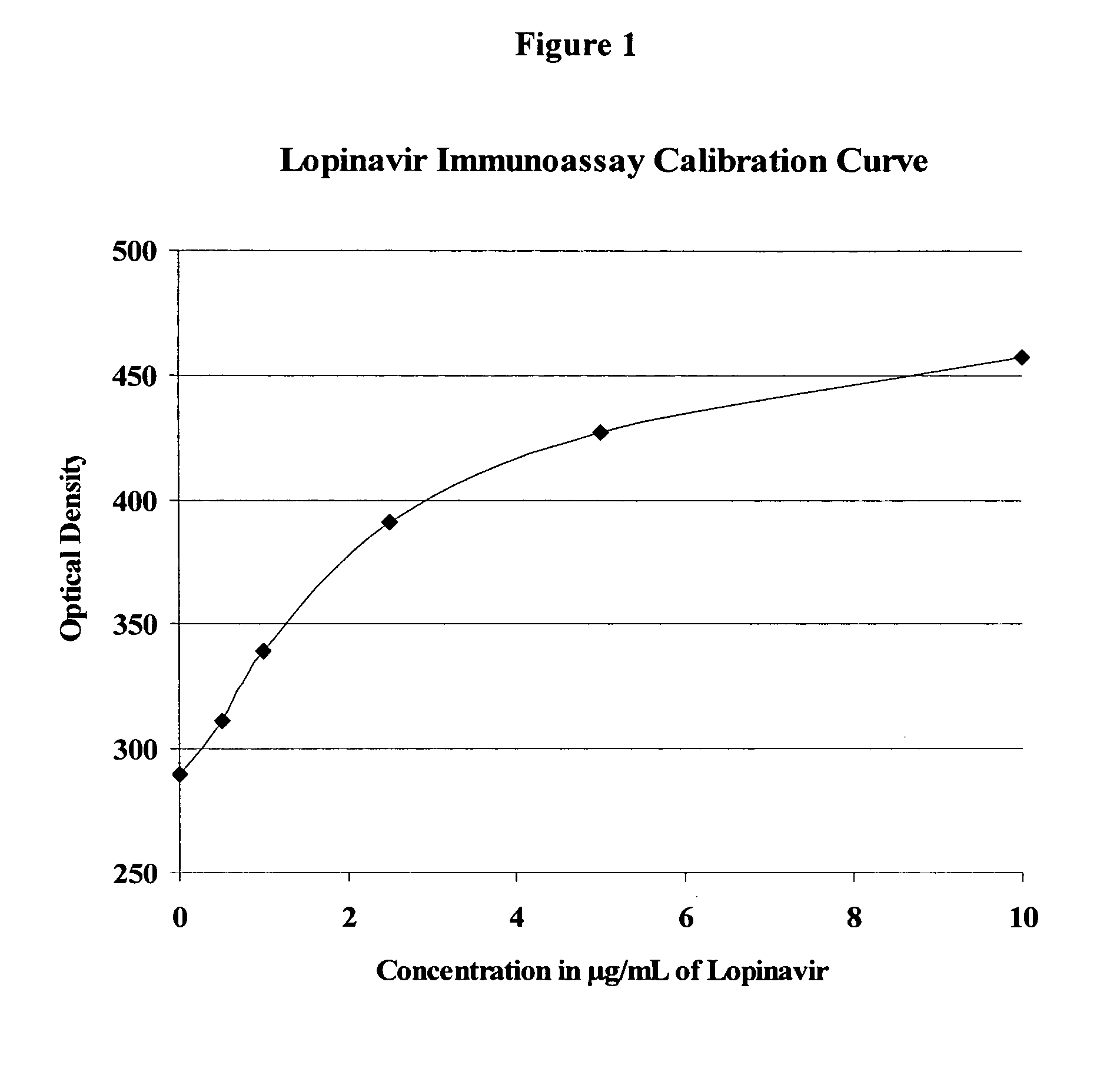Immunoassays, haptens, immunogens and antibodies for anti-HIV therapeutics
a technology of immunogens and antibodies, applied in the field of acquired immune deficiency syndrome, can solve the problems of not all patients respond optimally to the combination therapy for hiv, present serious health risks to patients, and destroy the body's immune system, and achieve the effect of inhibiting the propagation of hiv
- Summary
- Abstract
- Description
- Claims
- Application Information
AI Technical Summary
Problems solved by technology
Method used
Image
Examples
example 1
Preparation of a Hapten Comprising Met-Sensitive Moiety (A1)
1.1 Preparation of S(+)-3-hydroxytetrahydrofuran carbomyl-N-phenylalanine 2
A solution of Fmoc phenylalanine (3.3 g, 8.64 mmol) and DIEA (3.0 mL, 17.28 mmol) in dried dicholoromethane (DCM) (10 mL) was added to the chlorotrityl resin (1.08 mmol / g, 2 g). The suspension was shaken overnight at rt. The resin was then washed with DMF (3×10 mL), DCM (3×10 mL) and MeOH (3×10 mL) respectively and dried in vacuo to give 3.1 g of the resin. The resin gave a negative test for ninhydrin. To the resin was added a solution of 20% piperidine in DMF (15 mL) and the mixture was shaken for 30 min on a shaker. The resin was then filtered and washed with DMF (3×20 mL), DCM (3×20 mL) and MeOH (2×20 mL) respectively. The resin gave a positive test for ninhydrin. The choloroformate 5 (prepared by reaction of the alcohol with excess phosgene) was then added slowly to suspension of the resin in DCM (5 mL) and DIEA (1.9 mL, 11.9 mmol) at rt and...
example 2
Preparation of a Hapten Comprising Met-Sensitive Moiety (A2)
2.1 Preparation of 4
A solution of t-Boc epoxide 3 (2.63 g, 10 mmol) in saturated solution of ammonia in MeOH (50 mL) at ice bath temperature was stirred for 4 h. The solvent was then removed under reduced pressure. The crude residue was dissolved in THF (50 mL), DIEA (1.89 mL, 11 mmol) and benzylcholoro formate (1.87 g, 11 mmol) and stirred overnight. The reaction was quenched with water (50 mL) and extracted with ethyl acetate (2×100 mL). The combined organic layers were washed with saturated Na2CO3 (100 mL), brine (100 mL), dried (Na2SO4) and evaporated to dryness. The crude residue was purified on a column (silica gel, ethyl acetate:hexane, 60:40) to give the cbz protected product (2.48 g, 60%) as a foam. The product was dissolved in THF / HCl (4N, 100 mL) and stirred for 2 h. The solvent was removed to give pure 6 as a white solid (1.88 g, 100%).
2.2 Preparation of 6
To a stirred solution of amine 4 (942 mg, 3 mmol...
example 3
Preparation of a Hapten Comprising Met-Sensitive Moiety (A3)
3.1 Preparation of 7
To a stirred solution of the acid 2 (279 mg, 1 mmol) in DMF (2 mL) was added DCC (260 mg, 1.2 mmol) and NHS (120 mg, 1.4 mmol). The mixture was stirred for 6 h and then glycine (150 mg, 2 mmol) and DIEA (0.4 mL, 2 mmol) were added at rt and the reaction was stirred overnight. The solvent was then evaporated to dryness in vacuo. To the residue was added water (10 mL) and extracted with ethyl acetate (2×25 mL). The combined organic layer was then washed with HCl (1N, 4 mL), and saturated sodium bicarbonate (3 mL) and dried (Na2SO4). The ethyl acetate was removed under reduced pressure to give the crude product. The crude product was purified on a silica gel column (MeOH:DCM:AcOH, 10:90:0.1) to give pure product 7 (221 mg, 66%) as a white solid.
PUM
| Property | Measurement | Unit |
|---|---|---|
| concentrations | aaaaa | aaaaa |
| diameter | aaaaa | aaaaa |
| diameter | aaaaa | aaaaa |
Abstract
Description
Claims
Application Information
 Login to View More
Login to View More - R&D
- Intellectual Property
- Life Sciences
- Materials
- Tech Scout
- Unparalleled Data Quality
- Higher Quality Content
- 60% Fewer Hallucinations
Browse by: Latest US Patents, China's latest patents, Technical Efficacy Thesaurus, Application Domain, Technology Topic, Popular Technical Reports.
© 2025 PatSnap. All rights reserved.Legal|Privacy policy|Modern Slavery Act Transparency Statement|Sitemap|About US| Contact US: help@patsnap.com



